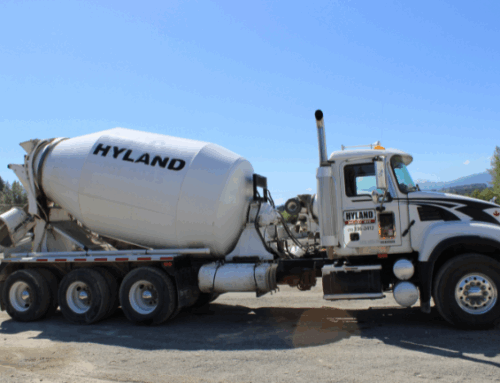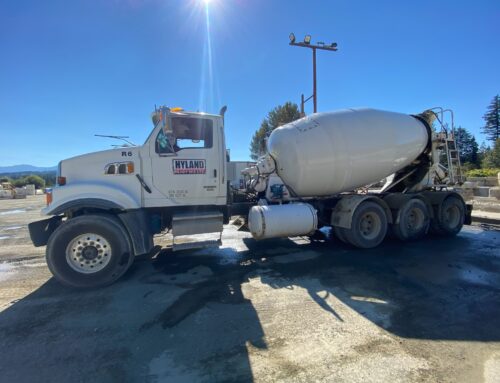Winter 2025 Concrete Guide for the Comox Valley

Winter on Vancouver Island doesn’t have to bring your concrete projects to a standstill. Whether you’re a commercial contractor tackling a seasonal build or a homeowner improving your outdoor space, colder weather in the Courtenay–Comox Valley region simply means taking the and using the right concrete mixto ensure a long-lasting, high-quality result. At Hyland Ready Mix, we support winter construction across the Island by supplying mixes designed specifically for cold-weather conditions—meeting all standards while concrete projects by helping you maintain proper set times and early strength gain.
When is it considered “cold weather” for concrete?
Cold weather concreting is defined as any period when average daily temperatures fall below 6°C for more than three consecutive days.
During these conditions—common from November through March in the Comox Valley, Hyland Ready Mix supplies mixes specifically adjusted for winter performance to ensure safe, reliable curing.
Winter concrete facts to keep in mind
- Fresh concrete can freeze before achieving sufficient strength, damaging the matrix and compromising durability.
- Cold temperatures slow hydration—below 10°C the set time increases significantly, and below 4°C hydration nearly stops entirely.
- Concrete should be protected from freezing until it achieves at least 7 MPa, ideally within the first 24–48 hours.
- Full standards are outlined in CSA A23.1-09 Section 21.
How Hyland Precast prepares winter concrete
From November 1 to March 15, Hyland Ready Mix heats all concrete to meet CSA winter specifications and maintain proper setting and strength gain.
Here’s how we do it:
- Heated water and heated aggregates simulate summer-like mixing conditions.
- Every component that contacts your mix is temperature-controlled.
- 17°C, taking into account that temperatures will drop during transport—about 25% of the difference between outdoor air and mix temperature per hour
- Mix designs can be adjusted for winter conditions, ensuring hydration continues and freezing is prevented.
How to pour concrete successfully in winter
1. Inspect your forms and sub-grade thoroughly
- Concrete protected from freezing typically reaches that minimum strength within 24 hours. Before pouring:
- Remove all snow and ice from forms.
- Ensure no ice is present on rebar.
- Never pour on frozen ground—it can cause uneven settlement and premature freezing of the concrete before it reaches minimum strength (3.5 MPA).
2. Use chemical accelerators
- Chemical accelerators help concrete set faster, reducing the amount of heating required to protect it. Accelerators do not weaken the concrete—they only shorten the time required to reach early strength.
- Slabs and walls thicker in mass retain internal heat better.
- A richer mix with more cement powder generates additional heat and sets faster.
- Insulating blankets help retain heat and prevent surface freezing
3. Use proper insulation
- Insulation is essential both before and after the pour. This step helps prevent thermal shock and premature freezing.
- Placing insulation on frozen ground for a few days can thaw it.
- After the pour, insulated thermal blankets help retain the heat produced during hydration.
- Pay special attention to corners and edges, which lose heat more quickly.
4. Consider hoarding and temporary heat
- Covering the work area with plastic sheeting or burlap and adding heat—known as hoarding—creates a warm environment for setting concrete.
- Avoid direct-vent space heaters inside the enclosure.
- Carbon dioxide from combustion can react with fresh concrete, causing surface carbonation and leaving a weak, powdery finish.
5. Use ICFs (insulated concrete forms) for walls
- ICFs are ideal for winter construction:
- They naturally prevent freezing.
- They retain the concrete’s heat of hydration.
- They minimize the need for artificial heating or hoarding.
- Be sure to cover the top of the forms to prevent heat loss.
Protect your investment: Build with confidence this winter
Concrete can absolutely be placed safely throughout the Vancouver Island winter—as long as proper precautions are taken. Hyland Precast and Hyland Ready Mix are here to help you:
- Choose the right winter mix
- Maintain proper curing conditions
- Avoid costly cold-weather setbacks
“Why risk your project?
Talk to the team at Hyland Precast or Hyland Ready Mix for an overview of your winter pour. We’re here to keep your project on track all year long.”
Resources for pouring concrete in cold weather



